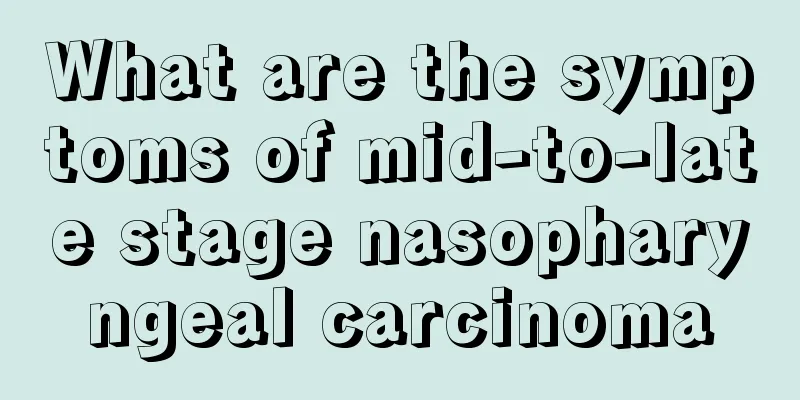What are the symptoms of mid-to-late stage nasopharyngeal carcinoma

|
Nasopharyngeal carcinoma is familiar to many patients today. When treating nasopharyngeal carcinoma, patients must treat it correctly. The following editor will introduce to you what are the symptoms of mid-to-late stage nasopharyngeal carcinoma? Nasopharyngeal carcinoma is one of the tumors with a higher incidence in Guangdong, Guangxi, Hunan, Fujian and other provinces in my country. The incidence rate in men is 2 to 3 times that in women, and the age group with a higher incidence is 40 to 50 years old. Since nasopharyngeal carcinoma is mostly poorly differentiated squamous cell carcinoma, radiotherapy is the first choice, and 60 Co or linear accelerator high-energy radiotherapy is often used. The 5-year survival rate of radiotherapy is about 45%. Local recurrence and metastasis of nasopharyngeal carcinoma after radiotherapy is the main cause of death. Some patients who still have residual local lesions after external irradiation of 60 to 70 Gy can cooperate with intracavitary afterloading therapy. Eye symptoms: The vision of patients with nasopharyngeal carcinoma may be affected, and the most common symptoms are exophthalmos and impaired vision. Exophthalmos may not be accompanied by symptoms of cranial nerve damage due to the metastasis of nasopharyngeal carcinoma to the eye socket. A mass can often be felt in the nasal orbit. Exophthalmos may be caused by nasopharyngeal carcinoma invading the ethmoid sinus and breaking into the eye socket, or by the intracranial cavernous sinus invading the superior orbital fissure and invading the eye socket. Symptoms of the anterior group of cranial nerves appear first, followed by exophthalmos. Nasopharyngeal carcinoma can also invade the patient's brain, thus showing more symptoms. For example: Invasion of the superior orbital fissure: oculomotor nerve III--In addition to moving outward and outward, the eyeball is in a fixed state. Sliding nerve IV-obstruction of moving the eyeball outward. Trigeminal nerve V-upper eyelid, forehead, eyeball sensory disorder. Abducens nerve VI-diplopia, eyeball abduction movement disorder. Invasion of the oval foramen, foramen rotundum and slope: Lower branch: sensory disorder in front of the ear, infratemporal, cheek, and front of the tongue. Through the above introduction, patients can have a clearer understanding of the symptoms of mid- and late-stage nasopharyngeal carcinoma. |
<<: Will there be no symptoms in the middle and late stages of lung cancer?
>>: Is nasopharyngeal cancer contagious? What are the causes of the disease?
Recommend
Colon cancer can cause intestinal obstruction
Colon cancer refers to malignant lesions of the c...
Washing your hair with rosemary can solve hair loss
In order to solve the problem of hair loss, peopl...
What should patients with esophageal cancer pay attention to in their diet
A common symptom of esophageal cancer patients is...
What are the principles of exercise for people with teratoma
Teratoma is closely related to daily life, so you...
What to do if your lips are too thin?
Many people feel inferior because of thin lips, w...
What to do if you have shoulder and neck pain? You need to know these methods
Shoulder and neck pain is a symptom. Many disease...
My knees crack when I stretch my legs
The sound made by joints is not unfamiliar to peo...
Three major characteristics of atrial fibrillation and two high-risk groups
Atrial fibrillation is a common persistent heart ...
What should I do if my gums are swollen, painful and festering? How to care?
Swollen and painful gums are a symptom, and may a...
Surgical treatment of pancreatic cancer
If pancreatic cancer is diagnosed early and there...
What is interventional treatment for liver cancer? Can liver cancer be cured after interventional treatment?
What is interventional treatment for liver cancer...
The cheekbones on my face twitch
Twitching of the cheeks and zygomatic bones may b...
What medicine should children take for urticaria
Urticaria is a common skin disease, which is caus...
What are the dietary care methods for colon cancer
In recent years, colorectal cancer has become one...
Will tendon sheath fibroma turn into cancer?
Tenosynovial fibroma, also known as giant cell tu...









